Jim Dalrymple’s DirecTV commercial
In case you’ve ever wondered where Jim keeps his new MacBook.
In case you’ve ever wondered where Jim keeps his new MacBook.
It’s not much of a contest. It all comes down to latency. I can’t wait to get my hands on the iPad Pro and Apple Pencil.
[H/T Loop reader Tom P]
That’s 6 GB of your storage consumed, whether you ask for it or not.
I wonder what happens if that fills your hard drive, or if you fill the drive while the download is in process.
[H/T, the simply magical not Jony Ive]
Good catch by Kirk McElhearn:
You’ll notice that there is no longer a Toslink (optical audio) output on the back of the Apple TV. The only option you have is HDMI; this is fine to connect to a TV or AV amplifier, but if you want to connect an Apple TV to a DAC, and then to an amp, you’re out of luck. Of course, one option is to use both: an Apple TV 3 for music only, and the new Apple TV for videos, games, apps, etc.
The TOSLINK connector was originally designed by Toshiba as a proprietary interface for Toshiba CD players (TOSLINK = Toshiba Link) but was widely adopted by the rest of the industry.
Personally, I’ve never used the optical interface on the old Apple TV. I won’t miss it, but for folks who do use optical, good to know the deal on this.
Not quite what I was asking for in this post, but a solid start. This is a spec table, comparing basic technical specs of the iPad Pro and the Surface Pro 3.
What’s missing, for me, is the technical comparison of the Surface Pro 3 stylus and the Apple Pencil. I assume someone is working on that one as we speak.
Jeremy Burge, writing on the Emojipedia blog, lays out the new emoji embedded in the latest beta release of iOS 9.1.
Hmmm, where’s that middle finger I’ve been hearing so much about. Oh, there it is, at the very end.
Caitlin McGarry, writing for MacWorld, pulled together a lot of info on the new iPhone 6s and 6s Plus.
Most importantly:
Set an alarm, because iPhone 6s and 6s Plus pre-orders kick off at 12:01 a.m. Pacific on Saturday, September 12. That means 3:01 a.m. for you East Coasters. At least you might not have to work the next day.
That’s tonight.
Daniel Eran Dilger, writing for Apple Insider, put together this terrific post, detailing the hands on experience with the iPad Pro and Apple Pencil. There are a number of videos embedded in the article, but the video below is the one I found most compelling.
The video shows Apple Pencil being put through some of its paces in Adobe Sketch. Watch the video, then come back and read on.
If you’ve ever used a tablet and pen/stylus, you’ve seen much of this before. From everything I’ve read and seen, Pencil captures the angle and force as well as any tablet, which may or may not include a pen for tablet, on the market, but it does so with no lag, becoming an almost perfect mirror of the tool being emulated. That’s what a high end tablet should do.
The “Aha” moment for me, involves content creation. I’ve always seen the iPad as a second class citizen when it comes to creating content. Unless I use an external keyboard, typing on an iPad is never as fast as on my laptop. Without outside assistance, the angle of the iPad is not easy to get just right, no match for my laptop’s hinged screen. Document creation and a management is more sophisticated, more capable in OS X. Drag and drop between applications, for example, has not been mirrored in iOS. Yet.
This is by no means a complaint. The advantage the iPad brings is obvious. Incredible portability, as well as compatibility between my iPhone and iPad and, more and more, between iOS and OS X. A perfect example of this is Safari. When I wake up in the morning, I grab my iPad and use Safari to dig in to the news of the day. When I move over to my Mac, I can access all the tabs I opened on my iPad in the OS X version of Safari. Easy peasy.
I love the portability of my iPad, but do the majority of my content creation on my Mac. I truly appreciate having both of them, truly appreciate the bridge Apple built between them.
Back to the “Aha” moment. Watching the video embedded below, I could see myself creating content on an iPad Pro that I could not create on my Mac, at least not without adding a pretty expensive tablet setup. It’s still pretty early in the game, app-wise, but I can see myself creating annotations, first cuts at graphics/logos/icons, page layouts, all with a direct touch and portability that I don’t have on my Mac.
With the iPad Pro, the stylus is a first class citizen, as opposed to a 3rd party add-on with limited app support. I’ll be interested to see how Pencil compares, head to head, with the stylus that ships with Surface and Samsung’s offerings. I suspect the Apple Pencil is head and shoulders a better experience.
Regardless, with the iPad Pro, I now see the iPad in a different light, not just as a content consumer, but as a first class content creation tool.
The Wall Street Journal ran a small interview this morning, giving Sir Jony the opportunity to talk about the creation of the Hermès Apple Watch and the partnership with Apple.
A few things that stood out:
Allowing Hermès’ symbols to upstage Apple’s is a first, Mr. Ive said. “I’ve been at Apple 23 years and this is conspicuous and singular. I’ve never known anything like this,” he said.
And on pricing:
The watch, which goes on sale Oct. 5, will be available in Apple and Hermès stores in 14 countries including the U.S., China, France and Switzerland. Prices range from $1,100 for the classic bracelet with a 38-mm case to $1,500 for the cuff, which comes with a 42-mm case.
And:
But for Mr. Ive, the attention he and Mr. Dumas lavished on the Apple Watch Hermès doesn’t give it any special status.
“Look at this next to one of the sport collection,” he says, referring to the $349 rubber-bracelet version that accounts for the majority of watch sales to date, according to people familiar with the matter. “There’s not one that had more care invested in its designing or making.”
That last point is important. Apple puts care and detailed craft into every product they make. The sports band matters to the design team, even though it is the cheapest band they sell. That’s a core principle.
Apple Inc’s financing plan for its new iPhones is likely to force U.S. carriers to work harder to win and retain customers.
Apple has done great things for customers when it comes to the carrier relationships.
Malicious apps that disable Android phones until owners pay a hefty ransom are growing increasingly malevolent and sophisticated as evidenced by a newly discovered sample that resets device PIN locks, an advance that requires a factory reset.
This has to be the most fucked up OS in history.
September 9 was a massive day for Apple. As I sat in the audience watching Tim Cook and Phil Schiller launching product after product, it struck me that Apple had really focused on the details with all of its latest releases—both software and hardware. That’s important for Apple because I believe that’s where one of the company’s main competitive advantages lies.
There were three main product announcements in the keynote: iPhone, iPad Pro, and Apple TV. There were however, several smaller announcements, like new Apple Watches and an iPhone upgrade program that will continue to propel Apple to the top of market in their respective categories. Just as Apple refines its strategy with innovation and precision, teams can enhance their own processes with Agile practices.
When I started thinking about the keynote announcements and talking to people about the products, I noticed that many were taking the announcements as separate, individual releases. You can certainly do that, but with Apple, it’s the entirety of the ecosystem, and therefore the announcements, that make the difference.
Each product on its own is impressive, but when put together, the enormity of what Apple released is truly stunning.
When looking at iPhone, you have to look at the new hardware, but also how the hardware and iOS 9 work together. This is a huge advantage for Apple because they control both. This is what makes iPhone so compelling.
We know that this is an “s” model year for iPhone, which means the outer design remains pretty much the same as the model released a year ago. I think we can all agree that the design of iPhone 6 is really good, so no major changes were needed.
Design elements aside, Apple changed everything else, making this a truly new device, and a compelling upgrade, especially for those people coming from the “5 series” models.
One of the most popular and most used features of iPhone is the camera. With a new 12-megapixel camera, Apple gave users the tools to take even better photos. However, raising the megapixels in the camera isn’t enough on its own, you also have to make sure the captured images look crisp and clear. Apple did that by designing its own signal processor to ensure color and detail are maintained in the image.
These are the details that Apple strives to get right. These are also the details that many consumers don’t recognize—they just see great photos and a higher megapixel camera.
Add to that Live Photos, a new feature that captures moments immediately before and after a picture is taken, and support for 4K video, and you have something really compelling for iPhone users.
Perhaps one of the greatest new features of the iPhone is 3D Touch. I say that because I see this as a new way to navigate iPhone.
We look to Apple for clarity in the user interface. What they did with 3D Touch is save us time when doing simple tasks on iPhone. For instance, from the Home screen, we have to go into an app and then dive into to whatever it is we want to do. When done, we have to back ourselves out again to the main screen. Depending on the app, it’s a few taps at the very least.
With 3D Touch we are able to initiate many tasks by just adding a bit of pressure to the app icon and choosing from the menu. This is called a “Peek” and it gives us a preview of a mail or message. Adding a bit more pressure and the message will “Pop” allowing us to interact with it as we normally would. All of this is done without losing our original position in the iPhone. This is huge.
Like notifications addressed a pain point for users in always having to navigate to different apps to see what’s new, 3D Touch addresses a navigation pain point that will eliminate the number of taps we need to make in order to get something done.
The changes in hardware, along with the integration of iOS 9, make the new iPhone 6s and iPhone 6s Plus a really compelling update.
As a long time user, I really like the new Apple TV. The Siri-enabled remote will help me navigate through content in a fraction of the time it took before. However, I’m not sure if I understand Apple when they say this is the future of TV.
To me, TV is about content and the future of TV should include ways to view that content without needing a cable or satellite subscription. With the many Apple TV enhancements yesterday, this fundamental content problem was not addressed.
It could be that Apple’s view of TV includes features to watch content without a subscription, but they just weren’t able to pull it off in time for the event. Bundling channels (or maybe they’ll be called apps), and being able to search across those channels for my programming is exactly what I would like in a future Apple TV service.
They did make some improvements with current partners, most notably MLB.com. That, I would agree is the future of TV. The demo was impressive, it was interactive, and if that’s what Apple has in mind for the future, I’m all in.
Much of the success of the current Apple TV will depend on if developers create apps for it. Games, shopping, and other entertainment and media will be welcome by users, but they have to be compelling enough to make it a goto device.
I like and appreciate the changes and features coming with Apple TV, especially Siri search, but I think it’s going to take some time for Apple to make this new platform the future.
Having said that, I will be the first one to buy Apple TV because the experience is going to be so much better. Apple once again solved a navigation problem that I welcome with open arms.
One question I had about iPad Pro going into the event was, “who is Apple going to market this device to? Professionals? Creatives? Gamers?” The answer appears to be, yes.
Apple’s Phil Schiller called on a number of companies to demo products across a variety of markets, effectively showing iPad Pro can work for everyone.
After using iPad Pro yesterday, I can tell you it’s gorgeous. The screen is outstanding, it’s fast, the battery will last 10 hours, and it’s lightweight. The addition of Apple Pencil certainly makes this a great device for creative professionals.
I didn’t get an opportunity to use the pencil, but watching others that did, there didn’t appear to be any latency when drawing on the iPad Pro screen. Latency in this kind of application is incredibly frustrating and would make the device virtually useless as anything other than a toy. That didn’t happen, so the opportunities for iPad Pro seem wide open.
I’m looking forward to getting my hands on an iPad Pro and using it for an extended period of time to see how it fits into my current workflow and lifestyle. I currently use both the iPad Air 2 and iPad mini 3 all the time, so this will be interesting for me.
In addition to the big announcements at the event, Apple will also release new gold and rose gold aluminum Apple Watch Sport models, new watch bands, Hermes watches, watchOS 2, tvOS, iOS 9, an iPhone upgrade program, and OS X El Capitan.
Most of these items got little to no attention on stage, which should give you an idea of just how big of a day it was for Apple.
I don’t look for Apple to stay on par with its competition, I look for them to set the standard for everything that’s going to happen in the next year. From what I saw yesterday, both at the keynote and touching the products myself, they’ve done that.
Fortune:
There are lots of things people wonder about Ahrendts. Why did she, the celebrated architect of Burberry’s turnaround, give up her post as CEO and uproot her family to become, at best, the third or fourth most powerful executive at the $183-billion-in-sales tech giant?Here’s another: What does Apple think Ahrendts—whom it paid an astounding $73.4 million in stock and cash in her first year—brings to a company that has redefined the technology and retail sectors, one that, at this point, seems not to need a whole lot of anything? And a third: What has she accomplished so far?
A lot of people don’t understand Ahrendts role at Apple, assuming she’d be as high profile at Apple as she was at Burberry. It’s the curse of short term thinking and not realizing that both Ahrendts and Cook are, as usual, playing the Long Game.
Farhad Manjoo, writing for the New York Times:
In many fundamental ways, the iPhone breaks the rules of business, especially the rules of the tech business. Those rules have more or less always held that hardware devices keep getting cheaper and less profitable over time. That happens because hardware is easy to commoditize; what seems magical today is widely copied and becomes commonplace tomorrow. It happened in personal computers; it happened in servers; it happened in cameras, music players, and — despite Apple’s best efforts — it may be happening in tablets.
All this is true.
Instead of killing Apple, commoditization caused something stranger — it hobbled Apple’s main competitor in the smartphone business: Samsung, which until last year was gaining a creeping share of the profits in the smartphone business. At its peak in mid-2013, Samsung was making close to half of every dollar in the smartphone business, according to the research firm Canaccord. (Apple was making the other half.)
But the rise of low-end, pretty great Android phones made by Chinese upstarts like Xiaomi — and the surging popularity of Apple’s large-screen iPhones — put Samsung in a bind. In July, Samsung reported its seventh straight quarter of declining profits. Canaccord’s latest estimate shows Samsung making 15 percent of profits in smartphones, with Apple making 92 percent. (The numbers add up to more than 100 because everyone else in the smartphone industry loses money, so their share of the profits is negative.)
You can expect Apple’s proportion to grow. As analysts at Credit Suisse explained in a note last week, only about 30 percent of the world’s 400 million iPhone users have upgraded to the large-screen models Apple introduced last year. Apple is bound to reap more money as the majority of its users inevitably jump to big phones over the next few years. In other words, for the foreseeable future, Apple stands virtually alone: It may be the only company making any money selling phones.
Cream rises to the top. Continued innovation (and a strong, well-protected ecosystem) protects Apple from commoditization.
Haven’t seen this in the wild yet, but I am a big fan of the new iPhone 6s ad shown during yesterday’s rollout. This is top work, my favorite ad in a long while, and another sign that Apple is running on all cylinders.
The ad is high energy (contrasting nicely with the some of the more laid back Apple Watch ads we’ve seen lately). It features some excellent voiceover work by (I believe) Lake Bell (big fan, perfect fit here, hope Apple continues to use her).
Perhaps the best part of the ad is the way it manages to show off “peek” and “pop”, the interface changes that come along with the new iPhone’s 3D Touch, what Apple calls “The next generation of Multi-Touch”.
Oh, and, Bill Hader. What’s not to like?
Yesterday’s “Hey Siri” event went impossibly well. Apple revealed one phenomenal new shiny after another. Since the original iPhone release back in 2007, I don’t remember an event with as much heft, as much magic, and with such terrific stage presence. To me, this was Apple in absolute top form.
Though there were a number of moments that vied for second place, by far my favorite part of the event was the announcement of the new Apple TV. Before the event started, I thought the only way a new Apple TV could differentiate itself from competition like Chromecast, Roku, etc., would be via new exclusive content, some blockbuster deal with TV networks and movie studios that could create a new ecosystem, walled off from the competition.
Somehow, Apple hit the ball out of the park, created a must have product based purely on the product itself, without the helping hands of a 3rd part content deal.
This from John Gruber, writing about the event for Daring Fireball:
The new Apple TV seems great for both video consumption and casual gaming. The MLB At Bat demo during the event was one of the coolest things I’ve ever seen. Not just because I’m a baseball fan, but because it presented a revolutionary way to watch live events, period. I think Apple TV might be the most disruptive product from Apple since the iPhone. Not the most lucrative, necessarily, but the most disruptive — in the sense of defining how all TVs will work in a few years.
Just so. This is the first TV experience that treats the content as an embedded element, sitting alongside search results and other embedded content, much like the windowing system on a computer. This is a big leap forward for TV interfaces, and I expect this approach will only get better, more sophisticated, over time.
As to gaming, I don’t see this as a direct challenge to the consoles, in that the new Apple TV controller is better suited to casual gaming than hard core first person shooters. That said, Apple TV will support 3rd party controllers that adhere to the MFi (made for iPhone/iPod/iPad) standard.
Short term, I’d expect Xbox, Playstation, and Wii to keep their place (and HDMI slot), working alongside the Apple TV. But there is already some creep between the two universes. For example, this from the Activision blog:
Guitar Hero Live is also coming to a wide array of devices, including consoles, mobile devices and Apple TV. Guitar Hero Live’s GH Live mode brings you closer to the live stage experience with live-action, first-person gameplay with crowds and bands that react dynamically to how you play. There’s also GHTV, the world’s first playable music video network, which lets you play along with a continually updated collection of official music videos spanning a variety of genres. Guitar Hero Live for Apple TV, iPad, iPhone, and iPod touch devices will come with the redesigned six-button guitar controller, which connects through Bluetooth so it be used across all supported Apple devices.
This post appeared yesterday, clearly in response to the Apple TV announcement. Short term, the consoles are safe. Long term, I’d expect there to be a slow migration, as developers explore Apple TV compatibility. If a complex, rapid fire controller is required, MFi compatible controllers already exist and are making improvements with each new release.
Bottom line, the Apple TV is definitely tops on my Christmas list, right alongside an iPhone 6s Plus and an iPad Pro. I’ve got a feeling it’s going to be a banner sales year for Apple, Inc.
I used my 20 megapixel DxO One camera connected to my iPhone 6 Plus to take the photos at the Apple Event today. I ran them through Pixelmator to cut down the size—I think they turned out really good.
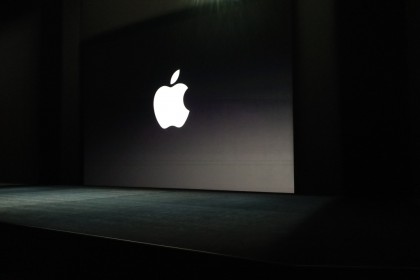
Apple Stage just before the keynote
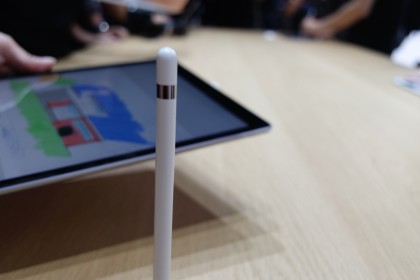
Apple Pencil
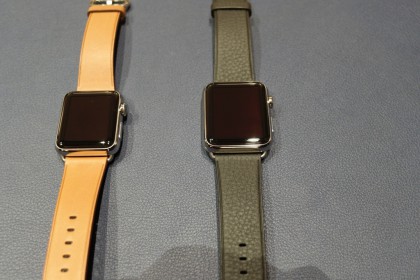
New Apple Watch Bands
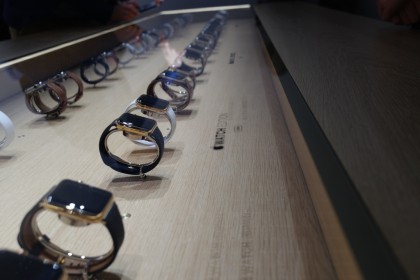
Apple Watch Collection
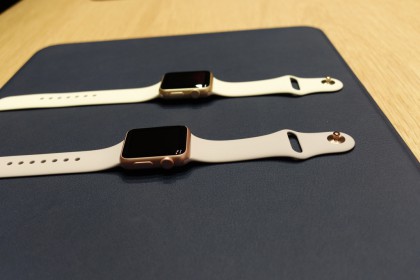
New Gold Apple Watch
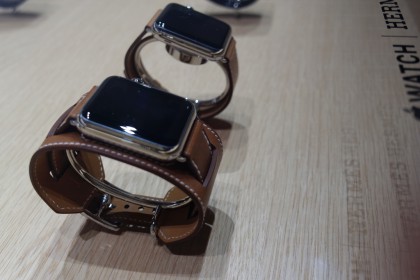
Hermes Apple Watch
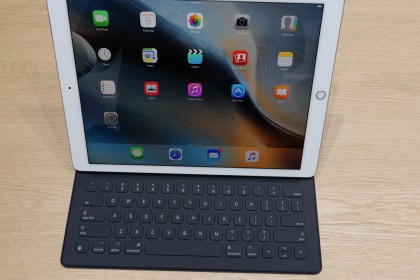
iPad Keyboard
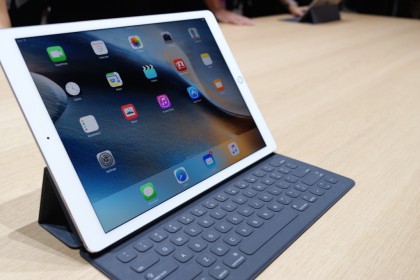
iPad Pro Keyboard
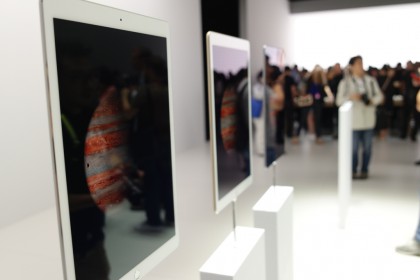
iPad on stands
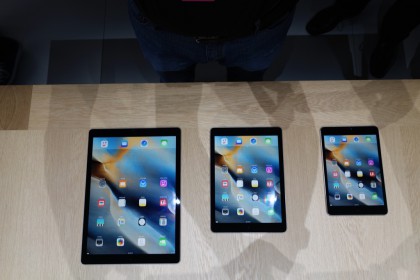
iPad Collection
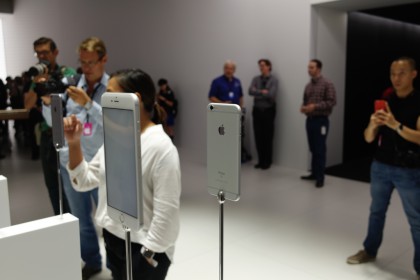
iPhone
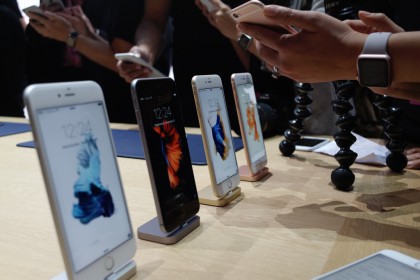
iPhone Collection
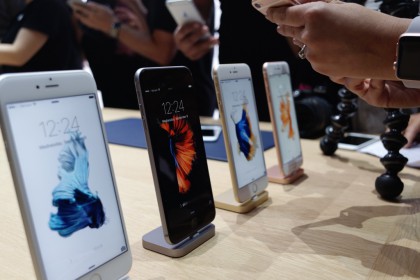
iPhone Collection
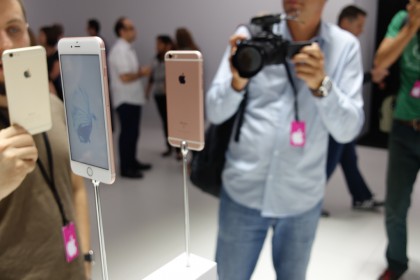
Rose Gold iPhone
ZDNet:
Apple has a new iPhone Upgrade Program that’s worth the look. And it may be even more disruptive than the technologies found in the company’s next iPhones.At this point, all of the four major U.S. carriers have installment plans available for handsets. Enter the iPhone Upgrade Program.
It’s very similar to what the carriers offer today but it might actually be a bit cheaper.
This has the potential to not only save the average consumer a little bit of money but also to undercut (and possibly upset) the traditional carriers. It will have the added benefit of getting the iPhone into many more hands, not just in the US but around the world.
If you couldn’t watch the event live this morning, Apple has posted the video on Apple.com. Apple hasn’t yet added it to iTunes but it will appear shortly. I think this was one of the strongest product launches in a long time.
Ars Technica:
Apple officially announced iOS 9 at WWDC in June, and adventurous users could start playing with the public beta in July, but today the company announced a public release date for the finished version of the operating system: Wednesday, September 16.The software update will arrive a couple of days ahead of Apple’s latest iPhones, which was to be expected given Apple’s past behavior. An unexpected benefit of this release is that it won’t drop support for any device currently running iOS 8—iOS 9.0 will run on iPhones as old as 2011’s 4S, iPads as old as 2011’s iPad 2 or 2012’s iPad Mini, and both the fifth- and sixth-generation iPod Touch.
I’m really looking forward to iOS 9 and the new features, especially split screen. Apple also quietly announced the release date for OS X 10.11 El Capitan – September 30th.
Polygon:
In a blog entry posted shortly after today’s event, Activision announced its slate of games headed to Apple TV. Among them are Skylanders SuperChargers, Guitar Hero Live and Geometry Wars 3: Dimensions Evolved writes communications manager Scott Lowe.“We’re continuing to offer new ways to play Skylanders and other games,” Lowe wrote, “whether you’re at home or on the go.” The titles will also be available on iPhone, iPad and iPod touch devices.
We’ll see more and more of these announcements in the coming weeks. It’s an exciting time for gamers, casual and otherwise. Less so for makers of dedicated consoles.
Bloomberg:
Apple has made many things over the years, but its process has remained essentially the same: Find something ugly and complicated and make it prettier and easier. Prettiness, in brushed aluminum, is more or less a permanent state. Ease, however, is constantly evolving, which is why a few days before the geek hootenanny known as Apple’s September Event, Jony Ive’s focus isn’t on a new version of Apple TV or an iPad the size of a doggy door, but on a feature. It’s called 3D Touch, and it makes using an iPhone even easier. “Ultimately, this is our focus,” says Ive, squeezing a new iPhone 6S. “This is what galvanizes our efforts right across the company.” And 3D Touch, he adds with emphasis, “is something we’ve been working on for a long time—multi, multi, multi years.”
Some great insider details in this piece. I know people at Apple who work behind the scenes and they’ve told me the months before an event like this are stressful, nerve-wracking, exciting and exhausting – and they love it.
CNET:
The new Apple TV, which ships in October and costs $149 (32GB) or $199 (64GB), comes with a Siri Remote that doubles as a game controller, with the Touch surface acting as a virtual directional pad.It also has a built-in accelerometer and gyroscope, much like Nintendo’s motion-sensing Wii remote.
However, Apple says, “For serious gamers, the new Apple TV supports MFi-based controllers that let you run, jump, shoot, kick, throw, punch or just about any other verb you can imagine.” (MFi is Apple’s Made for iPhone/iPad/iPod licensing certification program).
I can’t wait to see how game developers take advantage of the ability to use third-party game controllers.
Apple:
iPad has always offered a uniquely simple yet immersive experience. And now with its expansive 12.9-inch Retina display, nearly double the CPU performance of iPad Air 2, and refined Multi‑Touch technology, iPad Pro adds another dimension to that experience. It’s not just larger. It’s an iPad that lets you be more creative and more productive — at a whole new scale.
For me, the new iPad Pro was the biggest deal of the Apple Event and the one product I’ll be saving my next to useless loonies to try and afford. The screen size is massive, the new Pencil looks better than any stylus I’ve ever tried and, along with the processing power and new iOS 9, the Pro looks promising as a mobile photo and maybe even video editing device.
Apple:
TV is a major part of our lives. We gather together around our big screens to watch big shows and big events. Yet somehow, the overall experience of TV has continued to stagnate. Until now. It all starts by recognizing that apps are the future of television. HBO NOW, WatchESPN, Netflix, Hulu, iTunes — apps are quickly becoming how we watch today. So we built a new foundation around this vision — with a new operating system called tvOS, innovative ways to connect with your screen, and a smart use of Siri to search for something to watch. This is the new Apple TV. This is where television is headed.
As expected, Apple finally gave us a significant upgrade to the Apple TV. While not many will say it’s the end of traditional TV and the ways we view it, I certainly believe this might be a step along that path. And I think most will agree apps and games will be a huge driver for Apple.
Apple:
The moment you use iPhone 6s, you know you’ve never felt anything like it. With just a single press, 3D Touch lets you do more than ever before. Live Photos bring your memories to life in a powerfully vivid way. And that’s just the beginning. Take a deeper look at iPhone 6s, and you’ll find innovation on every level.
The Financial Times asked this morning, before the Apple Event had even started, “Is Apple running out of innovation for the iPhone?” I think that question has been answered. Plus, the new installment plans are going to put iPhones in the hands of even more people.
Yesterday, Jim posted a link to the Wristly State of the Apple Watch report.
Since then, Wristly has posted this infographic that lays out the details of the report graphically. Take a look.
Jeff Carlson lays out 6 somewhat hidden features in the OS X Photos applications. I knew most of them, but as always with these sorts of posts, the real value was in the ones I didn’t know. Nice job, Jeff.
An excellent find by Jeff Benjamin, over at iDownloadBlog. This eBay auction adds $100 to your iTunes balance for $75. You can buy multiple copies.
Does it work? Yes. I bought two of them, total of $150, now have an iTunes balance of $200.
You have to use PayPal to buy these. According to the auction page, supplies are limited. Interesting promotion.
Gee, does this graphic look even slightly familiar? Stay classy, Sony.
Oh, and in case you are wondering, the binary in the graphic translates to:
Game on.
Cause PlayStation and new Apple TV.
[Via the always excellent not Jony Ive]